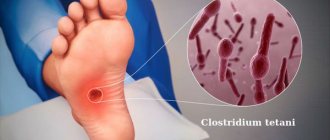Who can get rabies?
Rabies affects almost all species of terrestrial mammals, primarily carnivores (families canines, felines, mustelids, raccoons, etc.). Wild and domestic birds, rodents, and bats can also get sick. Every year in our country hundreds of cases of the disease are recorded among wild (foxes, raccoon dogs, wolves, etc.) and domestic (dogs, cats, cattle, horses) animals. There have been isolated cases of hydrophobia with fatal outcomes among people. The source of rabies is a wild animal that became infected in the natural environment, as well as a domestic animal that was attacked by another sick animal (wild or domestic). Humans become infected from sick animals.
How does infection occur?
The causative agent of rabies is a specific virus contained in the saliva of a sick animal. Human infection occurs through a bite and penetration of saliva from a sick animal into the wound. Having penetrated through damaged skin, the rabies virus spreads along the nerve trunks to the brain and spinal cord. This is where the virus multiplies and accumulates mainly. Then it penetrates the salivary glands and is released with saliva into the external environment. The virus appears in saliva 1-7 days before the first clinical signs of the disease. Therefore, you can become infected with rabies through a bite inflicted by an apparently healthy animal.
Infection can also occur if saliva gets on the mucous membranes of the eyes, nose, mouth, or damaged skin.
Scratches caused by claws are very dangerous: animals often lick their paws, so a sufficient amount of virus remains on the claws for infection.
You can also become infected when cutting up the carcass of a sick animal, as this often results in cuts to the fingers.
Unusual routes of infection should be mentioned. In recent years, the literature has described isolated cases of human infection through intact skin, by airborne droplets (in laboratory conditions, in a cave with millions of bats), through the placenta during pregnancy, and during organ and tissue transplantation. Cases of infection through the digestive tract have been described, so far only for animals. As for humans, to date there is not a single case of human illness known after consuming meat or milk of sick animals. This is due to the fact that the rabies virus rarely penetrates the blood and glandular organs. In addition, the virus is unstable in the external environment; it dies under normal pasteurization regimes, and when boiled, it dies instantly.
The most dangerous bites are those caused by rabid wolves, foxes, raccoon dogs and other wild carnivores and bats. Dog and cat bites are somewhat less dangerous. Cases of human infection after contact with a sick farm animal (cow, horse, goat, sheep, pig) are rare. Poultry, although they can get rabies, are not capable of infecting humans due to the lack of salivary glands. Unlike domestic birds, birds of prey (for example, falcons) can infect humans. However, these birds are very rare in the natural environment and the likelihood of their contact with humans is negligible. The possibility of infection of a person as a result of a bite inflicted by a rodent: rabbit, hare, squirrel, muskrat, rat, hamster, mouse cannot be ruled out. However, no reliable cases of human infection from these animals have been described in the world literature.
Routes of human infection
A person can become infected with rabies from an indoor or outdoor cat in several ways. The main routes of infection are bites and scratches, as well as the saliva of a sick pet coming into contact with damaged skin.
Preventive measures must be taken on the first day, so if there is a minimal probability of the animal having the disease, you should immediately consult a doctor and begin a course of injections.
If bitten by a cat
The main danger of animal rabies for humans is that the pet becomes infectious before the clinical picture of rabies appears. Most often, an owner or volunteer who feeds stray animals becomes infected if they are bitten by a cat, unaware that they are interacting with the carrier.
Careless games or the specific nature of the individual can cause not gentle biting, but a full-fledged bite with the fang penetrating through all layers of the skin. Blood comes out and mixes with the saliva of the infected pet, resulting in infection.
https://youtube.com/watch?v=YGryQslnhw8
The risk of infection increases if the pet begins to lick the wound. A larger amount of saliva increases the number of viral agents entering the human body.
If scratched by a cat
Scratches themselves do not pose a danger to humans. However, there is still a chance of infection if a cat scratches. This happens under the following conditions:
- the lower parts of the limbs are damaged, the pet’s blood may get into the scratch;
- accidental contact of cat saliva in the area of injury;
- independent treatment of open wounds of an animal with damaged skin of the hands.
Other routes of infection
Other routes of infection include contact of blood and saliva with human mucous membranes. This occurs after contact with a sick cat and ignoring disinfection measures. Also dangerous is allowing the pet to eat from the owner’s plate and feeding it with its own spoon. In addition to the fact that human food is harmful to pets, the risk of contracting the virus cannot be completely ruled out.
Another route of infection is licking the face or hands. The rough tongue of cats causes microcracks in human skin, through which saliva containing the disease agent enters.
What damage is considered the most dangerous?
The period from the bite to the onset of the disease (latent or incubation period) averages 30-50 days in humans, although it can last 10-90 days, in rare cases - more than 1 year. Moreover, the further the bite site is from the head, the longer the incubation period. Consequently, taking into account the localization (location) of the damage, bites to the head, face, and neck are especially dangerous. The category of severe (dangerous) injuries also includes bites on the fingers, because these parts of the body have many nerve endings. Bites to the forearm, shoulder, and torso are considered less dangerous. The incubation period lasts the longest for a bite on the legs.
What is rabies in cats?
Rabies is an infection caused by an RNA virus. Cats become infected with rabies after catching a sick small animal or receiving a bite from a rabid animal.
The virus lives in saliva, so the main method of transmission of the disease is through saliva during a bite. The incubation period lasts 2–3 weeks. The rate of damage to the animal’s body is affected by the location and extent of the wound.
Symptoms vary among different forms. The violent form becomes immediately noticeable to the owners: the cat caresses, rubs against the owner, or, on the contrary, sleeps a lot and hides in a dark place.
Her drooling increases. The fur on the chest is wet, becomes dirty, and icicles appear. As the disease progresses, the mouth opens unnaturally.
The cat is afraid of light and water. The animal eats little or not at all, but tries to chew on inedible objects. Becomes aggressive and attacks the owner. At such moments, it is almost impossible to drag the cat away.
At the last stage, the animal develops convulsions and paralysis occurs. The violent form is the most common. But sometimes there are no attacks of aggression. The cat hides in the dark and after 3-5 days the stage of paralysis begins.
What should you do if you are bitten by an animal?
The duration of the incubation period (i.e., the period before the onset of symptoms of the disease) in animals ranges from a week to several months (sometimes years), but already 5-10 days before the onset of the disease, the animal is contagious.
A characteristic sign of an animal disease in the first stage should be considered a change in behavior: an angry animal becomes affectionate, unreasonably animated, tries to lick the owner’s face; good - angry, irritable, does not respond to the owner’s call, hides in dark corners. The animal refuses its favorite food, but swallows inedible objects (wood, stones, etc.), and sometimes there is increased sensitivity to light and noise. Body temperature rises slightly. If we talk about wild animals, then for those who are sick, such a change will be the desire to make contact with a person: a healthy wild animal will never voluntarily go to a person and will run away whenever they try to get closer.
The initial stage of the disease is replaced by the second stage - the stage of excitation, in which the animal’s irritability increases and aggressiveness occurs. An animal can attack or bite for no apparent reason. Next comes the third, paralytic stage, very characteristic of the appearance of the animal: the fur is tousled, the lower jaw droops, the tongue falls out, saliva flows from the mouth. On the 8-10th day the animal dies.
Rabies in a dog.
In the initial period, the dog becomes depressed, responds reluctantly to calls, and lies down more. The appetite is sluggish, indifferent to water (but, as a rule, there is no hydrophobia). It must be emphasized that hydrophobia (fear of water) is not a characteristic sign of rabies in dogs. This is very important, since some people, seeing that a dog is not afraid of water (drinks water, swims across a river, etc.) consider it healthy and, if bitten, scratched or salivated by such a dog, do not take protective measures or seek medical help . By the end of the 2nd day of illness, anxiety and irritability often appear; the sick dog tries to go to some distant corner (under the porch, bed, etc.). Signs of clouding of consciousness occur, she barks for no reason, her voice becomes hoarse, dull, gasps for air and makes other involuntary movements, which never happens normally. Sometimes, as a result of itching at the site where she was bitten by a rabid animal, she chews on the healed wound. It is typical for the dog to swallow inedible objects: chips, stones, etc.
As a result of growing excitement, the dog runs away from home, running up to 50 km a day. Along the way, she silently attacks people and animals.
The period of excitement lasts 3-4 days, after which attacks of convulsions and paralysis occur. Dogs die on days 6-8 of illness. It should be remembered that the described picture of rabies in dogs is not always observed. But in any case, the animal’s normal behavior changes dramatically, which should alarm the owners and be the reason for inviting a veterinarian. Attempts to treat a dog that allegedly choked on a bone often resulted in rabies.
Rabies in a cat.
Rabies is more severe in cats than in dogs. The first signs of the disease come suddenly and are expressed by increasing anxiety and agitation. The meowing becomes hoarse, dull, the look (very characteristic!) is frightened, cautious. The cat refuses food and avoids its owners. The next day the cat becomes aggressive, with particular anger it attacks dogs and humans.
Excitation lasts 1-2 days, and then paralysis develops. Death occurs within 2-5 days. A characteristic feature of bites from a sick cat is a spasm of the masticatory muscles, as a result of which, after a bite, such a cat can be extremely difficult to tear away from the wound.
It should be emphasized that in case of any illness in the animal, and especially when symptoms of rabies appear, you should immediately contact the nearest veterinary station. Under no circumstances should you self-medicate an animal - this is deadly!
Signs of rabies in humans
When bitten by an infected animal, the rabies virus enters the bloodstream and lymph, reaches the fibers of nerve cells and spreads through them. The closer the bite site is to the head and neck, the more rapidly the disease develops. The virus quickly reaches the brain and affects the main “control centers” that are responsible for ensuring normal life.
Important! The rabies virus can be in the human body and not manifest itself in any way for 1 to 3 months. Cases have been described where the incubation period lasted several years.
Sometimes a wound after being bitten by a rabid cat will heal and not cause concern. But secondary inflammation with pain should alert the bitten person.
In humans, rabies also occurs in three stages, each of which manifests itself with specific symptoms.
The first is melancholic. The duration of this stage is from 24 to 80 hours.
Symptoms:
- inflammation of the wound: itching, pain, hyperemia (swelling, redness of surrounding tissues);
- uncritical but constant increase in body temperature to 37.5°C;
- headaches, weakness, gastrointestinal upset, vomiting, nausea;
- anxiety, depression, apathy or agitation, depression;
- if the bite site is close to the face, visual and olfactory hallucinations are possible - this means that the virus has attacked the brain;
- loss of appetite;
- sleep disturbance - insomnia, nightmares, delirium, manifestations of mental disorders.
The second is manic. Lasts 2–3 days, characterized by the following symptoms:
- Hydrophobia (hydrophobia). This symptom gave the second name to rabies. The point is not that the patient is afraid of water, but that due to a spasm of the swallowing muscles he cannot drink. Attempts to quench thirst cause cramps and vomiting.
- Facial muscles cramp. The eyeballs protrude from the sockets, the pupils are dilated, and the gaze is fixed on one point. The condition is accompanied by a rapid pulse and profuse sweating.
- Excessive excitement, aggressiveness, manifestation of rage, severe mental deviations. These phenomena are temporary. After the attack, the patient returns to an adequate state.
Interesting! It was the third phase that gave the disease its modern name: people thought that a demon was possessing a person: he went crazy, became possessed.
The third stage is depressive. Duration – about three days. At this stage, the following symptoms come to the fore:
- Convulsions and hallucinations disappear, as do agitation and aggressiveness.
- As a result of the destruction of nerve endings, sensitivity disappears.
- Damage to the motor centers leads to paralysis of the muscles and internal organs - the patient loses motor activity and appears calm on the outside.
- The temperature rises dangerously – up to 42°C. Blood pressure drops critically.
- Respiratory arrest, cardiac paralysis, death.
From the appearance of the first symptoms of rabies to death, it takes from 3 to 10 days. But all this will not happen if you immediately take emergency measures after you are bitten or scratched by a cat.
What should you do if you are bitten by an animal?
If a child or adult is bitten, scratched, slobbered by any animal, even an apparently healthy one, much less a neglected or wild one, or if there is a suspicion that it has rabies, you should immediately:
- Wash the wound intensively for 10-15 minutes with soap and water, which will wash away the animal’s saliva. It is recommended to wash deep wounds with a stream of soapy water, for example, using a syringe. There is no need to cauterize wounds.
- Apply a sterile bandage to the wound.
You should be warned about the danger of sucking the wound with your mouth.
After this, you must contact the nearest trauma center or any medical institution (clinic, hospital, medical center) as soon as possible. If possible, it is necessary to collect as much data as possible about the bitten animal (description of the animal, its appearance and behavior, presence of a collar, circumstances of the bite, etc.). If the animal is domestic (dog or cat) and has been vaccinated against rabies, then you must take with you a veterinary certificate confirming the vaccination or a registration certificate with a mark on the vaccination.
Rabies is dangerous!
1. Definition. Brief historical information about the disease
.
Rabies is an acute infectious disease of animals and humans caused by a virus that affects the central nervous system and is always fatal. Synonyms: hydrophobia, lat. -rabies, hydrophobia.
Rabies was known to people long before our era and is described in various ancient books. Already in Egyptian papyri, Indian sacred books Vedas, Greek and Roman sources, and then in the Bible, rabies was told about rabies, which is transmitted to people from enraged animals (wild and domestic). The dangers of this disease were written about in the Middle Ages, the Renaissance and later. The first mentions of human disease with hydrophobia in Belarus date back to the beginning of the 19th century, although it is known from ancient chronicles that cases of human rabies were noted earlier on the territory of the republic. Officially, the first case of hydrophobia in a person in the republic was registered in 1923.
Currently, rabies is widespread throughout the world. The only exceptions are Antarctica and the island states of Oceania. In the territory of the Republic of Belarus in recent years there has been a significant increase in the number of animals with rabies.
2. Who can get rabies?
Rabies affects almost all species of terrestrial mammals, primarily carnivores (families canines, felines, mustelids, raccoons, etc.). Wild and domestic birds, rodents, and bats can also get sick. Every year in our country hundreds of cases of the disease are recorded among wild (foxes, raccoon dogs, wolves, etc.) and domestic (dogs, cats, cattle, horses) animals. There have been isolated cases of hydrophobia with fatal outcomes among people.
The source of rabies is a wild animal that became infected in the natural environment, as well as a domestic animal that was attacked by another sick animal (wild or domestic). Humans become infected from sick animals.
3. How does infection occur?
The causative agent of rabies is a specific virus contained in the saliva of a sick animal.
Human infection occurs through a bite and penetration of saliva from a sick animal into the wound. Having penetrated through damaged skin, the rabies virus spreads along the nerve trunks to the brain and spinal cord. This is where the virus multiplies and accumulates mainly. Then it penetrates the salivary glands and is released with saliva into the external environment. The virus appears in saliva 1-7 days before the first clinical signs of the disease. Therefore, you can become infected with rabies through a bite inflicted by an apparently healthy animal. Infection can also occur if saliva gets on the mucous membranes of the eyes, nose, mouth, or damaged skin. Scratches caused by claws are very dangerous: animals often lick their paws, so a sufficient amount of virus remains on the claws for infection. You can also become infected when cutting up the carcass of a sick animal, as this often results in cuts to the fingers. Unusual routes of infection should be mentioned. In recent years, the literature has described isolated cases of human infection through intact skin, by airborne droplets (in laboratory conditions, in a cave with millions of bats), through the placenta during pregnancy, and during organ and tissue transplantation. Cases of infection through the digestive tract have been described, so far only for animals. As for humans, to date there is not a single case of human illness known after consuming meat or milk of sick animals.
This is due to the fact that the rabies virus rarely penetrates the blood and glandular organs.
In addition, the virus is unstable in the external environment; it dies under normal pasteurization regimes, and when boiled, it dies instantly. The most dangerous bites are those caused by rabid wolves, foxes, raccoon dogs and
other wild carnivores and bats. Dog and cat bites are somewhat less dangerous. Cases of human infection after contact with a sick farm animal (cow, horse, goat, sheep, pig) are rare. Poultry, although they can get rabies, are not capable of infecting humans due to the lack of salivary glands. Unlike domestic birds, birds of prey (for example, falcons) can infect humans. However, these birds are very rare in the natural environment and the likelihood of their contact with humans is negligible. The possibility of infection of a person as a result of a bite inflicted by a rodent: rabbit, hare, squirrel, muskrat, rat, hamster, mouse cannot be ruled out. However, no reliable cases of human infection from these animals have been described in the world literature.
4. What damage is considered the most dangerous?
The period from the bite to the onset of the disease (latent or incubation period) averages 30-50 days in humans, although it can last 10-90 days, in rare cases - more than 1 year. Moreover, the further the bite site is from the head, the longer the incubation period. Consequently, taking into account the localization (location) of the damage, bites to the head, face and neck are especially dangerous. The category of severe (dangerous) injuries also includes bites on the fingers, because these parts of the body have many nerve endings. Bites to the forearm, shoulder, and torso are considered less dangerous. The incubation period lasts the longest for a bite on the legs.
6. What should you do if you are bitten by an animal?
The duration of the incubation period (i.e., the period preceding the onset of symptoms of the disease) in animals ranges from a week to several months (sometimes years), but already 5-10 days before the onset of the disease the animal is infectious. A characteristic sign of an animal disease in the first stage should be considered a change in behavior: an angry animal becomes affectionate, unreasonably animated, tries to lick the owner’s face; good - angry, irritable, does not respond to the owner’s call, hides in dark corners. The animal refuses its favorite food, but swallows inedible objects (wood, stones, etc.), and sometimes there is increased sensitivity to light and noise. Body temperature rises slightly. If we talk about wild animals, then for those who are sick, such a change will be the desire to make contact with a person: a healthy wild animal will never voluntarily go to a person and will run away whenever they try to get closer. The initial stage of the disease is replaced by the second stage - the stage of excitation, in which the animal’s irritability increases and aggressiveness occurs. An animal can attack or bite for no apparent reason. Next comes the third, paralytic stage, very characteristic of the appearance of the animal: the fur is tousled, the lower jaw droops, the tongue falls out, saliva flows from the mouth. On the 8-10th day the animal dies.
When talking about the clinical manifestations of rabies in animals, one should dwell in detail on the behavior of sick dogs and cats, because
most often encounter these animals .
Rabies in a dog.
In the initial period, the dog becomes depressed, responds reluctantly to calls, and lies down more.
The appetite is sluggish, indifferent to water (but, as a rule, there is no hydrophobia). It must be emphasized that hydrophobia (fear of water) is not a characteristic sign of rabies in dogs. This is very important, since some people, seeing that a dog is not afraid of water (drinks water, swims across a river, etc.) consider it healthy and, if bitten, scratched or salivated by such a dog, do not take protective measures or seek medical help .
By the end of the 2nd day of illness, anxiety and irritability often appear; the sick dog tries to go to some distant corner (under the porch, bed, etc.). Signs of clouding of consciousness occur, she barks for no reason, her voice becomes hoarse, dull, gasps for air and makes other involuntary movements, which never happens normally. Sometimes, as a result of itching at the site where she was bitten by a rabid animal, she chews on the healed wound. It is typical for the dog to swallow inedible objects: chips, stones, etc. As a result of growing excitement, the dog runs away from home, running up to 50 km a day. Along the way, she silently attacks people and animals. The period of excitement lasts 3-4 days, after which attacks of convulsions and paralysis occur. Dogs die on days 6-8 of illness. It should be remembered that the described picture of rabies in dogs is not always observed. But in any case, the animal’s normal behavior changes dramatically, which should alarm the owners and be the reason for inviting a veterinarian. Attempts to treat a dog that allegedly choked on a bone often resulted in rabies.
Rabies in a cat.
Rabies is more severe in cats than in dogs. The first signs of the disease come suddenly and are expressed by increasing anxiety and agitation. The meowing becomes hoarse, dull, the look (very characteristic!) is frightened, cautious. The cat refuses food and avoids its owners. The next day, the cat becomes aggressive, with particular anger it attacks dogs and humans. Excitation lasts 1-2 days, and then paralysis develops. Death occurs within 2-5 days. A characteristic feature of bites from a sick cat is a spasm of the masticatory muscles, as a result of which, after a bite, such a cat can be extremely difficult to tear away from the wound.
It should be emphasized that in case of any illness in the animal, and especially when symptoms of rabies appear, you should immediately contact the nearest
veterinary station. Under no circumstances should you self-medicate an animal - this is deadly!
6. What should you do if you are bitten by an animal?
It is very important to teach the child (his parents) to properly provide first aid to himself and others in case of a bite.
If a child or adult is bitten, scratched, slobbered by any animal, even an apparently healthy one, much less a neglected or wild one, or if there is a suspicion that it has rabies, you should immediately:
1) intensively wash the wound with soap and water for 10-15 minutes, which will wash away the animal’s saliva. It is recommended to wash deep wounds with a stream of soapy water, for example, using a syringe. There is no need to cauterize wounds.
2) apply a sterile bandage to the wound.
You should be warned about the danger of sucking the wound with your mouth.
After this, you must contact the nearest trauma center or any medical institution (clinic, hospital, medical center) as soon as possible. If possible, it is necessary to collect as much data as possible about the bitten animal (description of the animal, its appearance and behavior, presence of a collar, circumstances of the bite, etc.). If the animal is domestic (dog or cat) and has been vaccinated against rabies, then you must take with you a veterinary certificate confirming the vaccination or a registration certificate with a mark on the vaccination.
7.
What will you do with an animal that has bitten you?
It is very important to indicate that simultaneously with contacting a doctor about a bite, it is necessary to take measures regarding the bitten animal (it must be tied up, isolated) and call a veterinarian for consultation. Appearingly healthy pets (dogs or cats) are subject to veterinary supervision for 10 days from the date of the bite. A sick animal must be euthanized. It is impossible to save him. As the disease progresses, the behavior of such an animal is uncontrollable. It is important to prevent human infection.
8. What measures do you know to prevent rabies in animals?
Should a person, caring for the safety of his life, refuse to communicate with animals? Not a single mechanical toy can replace human communication with a living creature of another species. They give us their love and affection, heal us, make us kinder and more humane. We must always remember that animals need care and supervision; they, like people, are susceptible to many diseases. In order to prevent rabies in domestic animals, the Rules for keeping them should be followed:
within three days, register the purchased animal and report it to the veterinary station;
It is mandatory to vaccinate your pet (over 3 months old) against rabies every year; it is better to do this in the winter and spring, especially before going outdoors;
walk animals in specially equipped areas or vacant lots, take dogs outside on leashes and muzzles (this will protect the animal from possible contact with sick wild or stray animals and eliminate the possibility of your animal biting anyone);
You cannot bring dogs and cats to shops, catering and consumer services establishments, schools and preschool institutions, public buildings, parks, squares, stadiums, markets;
minors are prohibited from walking dogs of potentially dangerous breeds;
Under no circumstances should you leave or abandon your animals unattended on the streets, squares, markets, entrances and other places, including in the country.
The best way to prevent rabies in wild animals is to vaccinate them by placing baits containing the vaccine near their natural habitats.
9. Are there any treatments for rabies?
TO
Unfortunately, to date, a person with rabies cannot be cured. Treatment is reduced to alleviating the general condition of the patient. In this regard, the prevention of rabies becomes extremely important in the fight against this disease. It includes the fight against sources of infection (animals with rabies) and the prevention of the disease in humans.
10. What preventive measures are there if you are bitten by an animal?
All kinds of recommendations for the prevention and treatment of rabies - the destruction of enraged animals, cauterization of bitten areas in people with a hot iron - did not produce any effect. Almost every person bitten by a rabid animal was doomed to death. Until the 80s of the 19th century, people did not have a reliable means of protection against this terrible disease.
The great French scientist Louis Pasteur has the honor of creating a vaccine against rabies, which was successfully used for the first time on July 6, 1885. Then, thanks to vaccination, a boy bitten by a rabid dog was saved. And some time later, in a French village, children playing were attacked by a rabid dog. Defending them, fifteen-year-old shepherd Jean Jupille accomplished a real feat. He managed to tie the dog's face with a belt whip and kill it with his wooden shoe. But the boy's entire body was covered with wounds. Barely alive, Jean was brought to Paris. Pasteur saved the hero.
To this day, vaccinations remain the only reliable means of protecting people after being bitten by an animal sick or suspected of having rabies. These include the administration of a vaccine and, if necessary, immunoglobulin.
What you need to know about preventive vaccinations:
-if the doctor prescribed vaccinations, they should be started immediately;
- you should never skip the next vaccination;
-the course of vaccinations prescribed by the doctor must be completed in full;
-a person who is vaccinated is not dangerous to anyone;
- during vaccinations, you should not drink alcoholic beverages for 6 months after their completion; you should avoid overwork, hypothermia, and overheating.
Along with vaccinations, on the recommendation of Belarusian scientists, antibiotic prophylaxis is also carried out.
11. How to avoid being bitten or salivated by unknown animals?
Children are more likely to suffer from animal bites, so it is necessary to constantly educate them and try to avoid unnecessary contact with animals, especially wild and/or stray ones:
You should not play with unfamiliar dogs, cats and other animals; it is better to stay at a safe distance from them;
should not be picked up at the dacha, in the forest, etc. wild animals. Hedgehogs and small rodents can also carry rabies. Incorrect or inappropriate behavior of a child who, due to his age, will not be able to correctly assess the situation, can lead to aggression in any animal, especially a sick animal;
It is better not to pick up homeless stray or sick animals, but if you do, then find an opportunity to quickly vaccinate the animal and show it to a veterinarian;
You should not take an animal “for the summer holiday season”: by throwing it away, you increase the risk of rabies in the given region. It is better not to send children under 12-14 years of age to walk a dog on their own, especially if it is a large and/or aggressive breed of animal. The child may not be able to cope with it, and in the event of a non-standard situation, he may not be able to adequately explain the essence of what happened.
REMEMBER
are very dangerous .
The saliva of wolves, foxes, and raccoons is permeable and contains a large amount of virus.
But you also need to be careful with your pets.
A dog is a good friend and helper of a person, but 85% of people who sought medical help for bites suffered precisely because of improper keeping of domestic
Homeless, stray and unsupervised dogs are especially dangerous. Proper keeping of pets is one of the most important conditions for preventing rabies infection.
If you notice any changes in the animal's behavior,
Take him to your veterinarian immediately.
Rabies is a relatively rare disease, and medicine does not have the means to treat it. However, highly effective vaccines
protecting people from this disease. Therefore, after an animal bite, you should wash the injury site with soap and water, treat it with iodine tincture and consult a doctor.
Only a doctor can determine the need for vaccination. Unauthorized interruptions in vaccination, termination and reduction of the course of vaccinations prescribed by a doctor are unacceptable, because In such cases, the development of immunity is delayed and there is a risk of disease. During
vaccination, it is strictly forbidden
to drink alcoholic beverages, because alcohol reduces the body's overall resistance and often causes unsuccessful vaccinations. You should follow a normal sleep and rest schedule, spend more time in the fresh air, and it is not recommended to overwork or overcool.
Need to know
that the saliva of animals becomes infectious 10 days before the onset of the disease. Therefore, if a person is bitten by an animal, under no circumstances should he be killed within the next 10 days, i.e. the period required for veterinary observation.
If during this time the animal remains healthy, vaccinations against rabies are not carried out.
- If you are bitten by any animal, immediately contact the nearest medical facility.
- Avoid unnecessary contact with wild and stray pets.
- Timely vaccinations will protect you from rabies.
- Animals are vaccinated against rabies in all veterinary institutions free of charge.
The material was prepared by the head of the department of hygienic education I.V. Varada.
| print version | Version for MS Word |
What do you do with an animal that has bitten you?
It is very important to indicate that simultaneously with contacting a doctor about a bite, it is necessary to take measures regarding the bitten animal (it must be tied up, isolated) and call a veterinarian for consultation. Appearingly healthy pets (dogs or cats) are subject to veterinary supervision for 10 days from the date of the bite.
A sick animal must be euthanized. It is impossible to save him. As the disease progresses, the behavior of such an animal is uncontrollable. It is important to prevent human infection.
Signs of infection in an animal
A person can become infected with rabies only through contact with a sick animal. The most common cause of infection is the bites of stray animals: dogs and cats. They, in turn, can catch the virus from wild animals.
Most often, a person becomes infected with rabies after contact with a sick stray animal.
An infected cat, as rabies progresses, behaves aggressively.
The cause of human infection can be not only the bite of a cat with rabies, but also its licking of areas of the body with microdamages and wounds. Saliva can also transmit infection, and therefore it is important to know what a sick animal looks like in order to avoid close contact with it.
Signs of rabies do not always manifest themselves in the form of open aggression. Initially, the cat may behave as usual and show affection.
Already in the later stages of the disease, the following symptoms are observed:
- aggressiveness;
- foam at the mouth associated with increased salivation;
- muscle cramps;
- refusal of food;
- fear of water;
- loss of the instinct of self-preservation, lack of fear;
- ignoring pain;
- general painful appearance.
A sick animal dies on average 5 to 12 days from the moment of infection.
What measures do you know to prevent rabies in animals?
Should a person, caring for the safety of his life, refuse to communicate with animals? Not a single mechanical toy can replace human communication with a living creature of another species. They give us their love and affection, heal us, make us kinder and more humane. We must always remember that animals need care and supervision; they, like people, are susceptible to many diseases.
In order to prevent rabies in domestic animals, the Rules for keeping them should be followed:
- within three days, register the purchased animal and report it to the veterinary station;
- It is mandatory to vaccinate your pet (over 3 months old) against rabies every year; it is better to do this in the winter and spring, especially before going outdoors;
- walk animals in specially equipped areas or vacant lots, take dogs outside on leashes and muzzles (this will protect the animal from possible contact with sick wild or stray animals and eliminate the possibility of your animal biting anyone);
- You cannot bring dogs and cats to shops, catering and consumer services establishments, schools and preschool institutions, public buildings, parks, squares, stadiums, markets;
- minors are prohibited from walking dogs of potentially dangerous breeds;
- Under no circumstances should you leave or abandon your animals unattended on the streets, squares, markets, entrances and other places, including in the country.
The best way to prevent rabies in wild animals is to vaccinate them by placing baits containing the vaccine near their natural habitats.
What is rabies in a cat?
The course of the disease in cats is not much different from the course of the disease in other animals. The onset of the disease is associated with the entry of a virus into the body, which begins its journey to the brain through the blood and lymph.
This pathogen is persistent and persists for a long time in the corpses of dead animals. In the cold it remains active for 2 years, but heating destroys this agent. Also, phenolic compounds, alkaline solutions and formaldehyde inhibit the effect of the virus.
Understanding what rabies is in a cat is quite simple: you need to understand the mechanism of action of the virus and the consequences of infection.
The agent itself is divided into 2 types:
Urban. An aggressive pathogen that has a short incubation period and leads to rapid death.
Forest. Wild animals are susceptible to it, however, over generations they develop adaptability: foxes, wolves, raccoons remain carriers, but do not show manifestations of the disease. However, the bite of such an animal is also dangerous for domestic animals, including cats, which are allowed to roam freely.
There are 3 forms of the disease in cats:
A quiet course is characterized by the absence of an aggressive phase. This form is characterized by the most rapid progression - the animal falls into apathy, then paralysis occurs, respiratory depression occurs, and the pet dies.
Atypical rabies is extremely rare. It is difficult to recognize due to the almost complete absence of symptoms. Attentive owners may notice the animal's drowsiness, lethargy, and lack of interest in games. With this form, an adult can live for several months. According to some studies, this form is sometimes curable.
The violent form is the most famous and widespread. The disease has 3 stages, and the second is extremely dangerous for others. Mechanism of pathology:
Stage of melancholy. First, some signs of behavior change appear: an increased need for affection or, conversely, a desire to hide in dark corners. Next, damage to the nervous system manifests itself, consisting in uncontrolled movements of the jaws. Subsequently, the desire to eat inedible objects develops, salivation increases, and vomiting develops.
Excitement stage. The cat demonstrates uncontrollable aggression towards people, animals and even objects. It is impossible to recognize the beginning of the attack. When bitten by hard objects, jaw fractures occur and teeth crumble. Once outside, a sick individual can run 50 km, spreading the virus along the way.
Stage of depression. The violence passes, paralysis of the larynx develops, preventing drinking water and eating. Later, the hind limbs fail, and the cat has difficulty moving. The final hours are coma. Having fallen into it, the animal dies from exhaustion or respiratory failure.
What preventive measures are there if you are bitten by an animal?
All kinds of recommendations for the prevention and treatment of rabies - the destruction of enraged animals, cauterization of bitten areas in people with a hot iron - did not produce any effect. Almost every person bitten by a rabid animal was doomed to death. Until the 80s of the 19th century, people did not have a reliable means of protection against this terrible disease.
The great French scientist Louis Pasteur has the honor of creating a vaccine against rabies, which was successfully used for the first time on July 6, 1885. Then, thanks to vaccination, a boy bitten by a rabid dog was saved. And some time later, in a French village, children playing were attacked by a rabid dog. Defending them, fifteen-year-old shepherd Jean Jupille accomplished a real feat. He managed to tie the dog's face with a belt whip and kill it with his wooden shoe. But the boy's entire body was covered with wounds. Barely alive, Jean was brought to Paris. Pasteur saved the hero.
To this day, vaccinations remain the only reliable means of protecting people after being bitten by an animal sick or suspected of having rabies. These include the administration of a vaccine and, if necessary, immunoglobulin.
What you need to know about preventive vaccinations:
- if the doctor has prescribed vaccinations, they should be started immediately;
- Under no circumstances should you skip the next vaccination;
- the course of vaccinations prescribed by the doctor must be completed in full;
- a person who is vaccinated is not dangerous to anyone;
- During vaccinations, you should not drink alcoholic beverages for 6 months after their completion; you should avoid overwork, hypothermia, and overheating.
Along with vaccinations, on the recommendation of Belarusian scientists, antibiotic prophylaxis is also carried out.
Vaccinating cats against rabies: when to vaccinate
There is no cure for rabies. The only way to avoid the disease is timely vaccination. The vaccination is given to a kitten at the age of 3 months.
The animal must be healthy. 2 weeks before the injection, the kitten must be given anthelmintic drugs.
Vaccines that have proven positive:
- Rabikan;
- Quadriket;
- Leucoriphenin;
- Nobivak.
Be sure to read:
Hemobartonellosis in cats: what is it, causes, symptoms and methods of treatment, prevention
They are easily tolerated by cats and do not cause discomfort. Before the first vaccination, contact of the animal with sick individuals should be avoided.
It is not advisable to let your cat outside. Vaccinations in Russia are provided free of charge in state veterinary clinics.
How to avoid being bitten or salivated by unknown animals?
Children are more likely to suffer from animal bites, so it is necessary to constantly educate them and try to avoid unnecessary contact with animals, especially wild and/or stray ones:
- You should not play with unfamiliar dogs, cats and other animals; it is better to stay at a safe distance from them;
- should not be picked up at the dacha, in the forest, etc. wild animals. Hedgehogs and small rodents can also carry rabies. Incorrect or inappropriate behavior of a child who, due to his age, will not be able to correctly assess the situation, can lead to aggression in any animal, especially a sick animal;
- It is better not to pick up homeless stray or sick animals, but if you do, then find an opportunity to quickly vaccinate the animal and show it to a veterinarian;
- You should not take an animal “for the summer holiday season”: by throwing it away, you increase the risk of rabies in the given region. It is better not to send children under 12-14 years of age to walk a dog on their own, especially if it is a large and/or aggressive breed of animal. The child may not be able to cope with it, and in the event of a non-standard situation, he may not be able to adequately explain the essence of what happened.
Can a person get rabies from a cat?
So is rabies transmitted from cats to humans or not? Yes, all experts answer this question positively.
Typically, wild and forest animals are carriers of this disease. But if an ordinary person rarely has to come into contact with a wild animal, then he communicates with a domestic animal quite often - he can sleep with it, pet it, feed it.
Constant contact with an infected pet will quickly lead to rabies infection.
At the same time, the owner may not know for a long time that his pet is a carrier of the virus.
It is worth noting! The rabies virus in infected pets can be detected in saliva 8-10 days before the onset of the first symptoms. In this case, the incubation period can last a long time, during which the owner may not suspect the presence of this pathological process.
If you are wondering when cat bites are a real threat, they can pose a danger from the first days of your pet's infection. The virus enters the saliva almost immediately, for this reason any contact with such an animal can become a serious health threat.
The possibility of a person contracting rabies from a cat may depend on the nature of interaction with the infectious animal. There can be 3 types:
- the first type is various touches, feeding the animal, licking the area of human skin without damage by the pet. During exposure of this species, no preventive measures are necessary;
- second type. Squeezing open areas of the skin during a bite, scratch, or abrasion;
- third type. Contacts of this type are the most serious and often lead to infection - bites, deep scratches, the biting animal can also secrete saliva, which gets into the wounds and mucous membranes.
The first type of contact is not dangerous, but the last two lead to infection. They require mandatory implementation of the necessary preventive measures, because they are the most dangerous and serious.
Important! The closer the bite or scratch is to the head, the faster the virus will penetrate the body and begin its active development.
It is also worth paying attention to the size and degree of scratches and bites. If they are deep and extensive, the risk of infection will be much higher. It is imperative to give rabies injections to a person before the first clinical signs appear, otherwise you may simply not have time to save the victim’s life. It is important to perform this procedure as soon as possible after bites or scratches from a sick animal.








